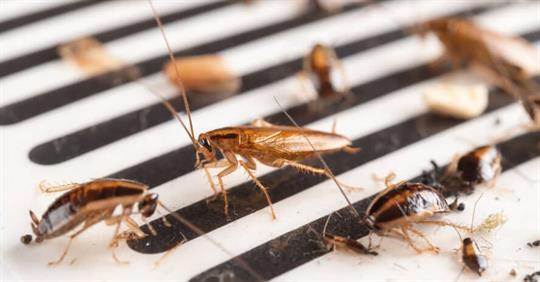Many people think of cockroaches as disgusting pests that only inhabit the homes of hoarders or other unkempt areas. Unfortunately, even the homeowners with the strictest cleaning schedules aren’t necessarily safe from cockroaches. But if wiping down the countertops every day won’t guarantee a roach-free home, what will?
First, we need to go to the source of the problem: why a clean house may have cockroaches to begin with.
Conducive Conditions for Cockroaches
A conducive condition is any condition that causes something to happen — in this case, the following conducive conditions can draw cockroaches (and other pests) to your home.
Access to Water
Many species of cockroaches are attracted to excess moisture and damp areas. Another way to think of it: anything that can contribute to mold growth can also attract cockroaches.
Any area that allows water to gather can be a conducive condition. Check your plumbing in the interior of your home (such as under sinks) and around the exterior of your home (at your hose bibb or around outdoor faucets). Aesthetic features such as ponds, birdbaths, wagons, buckets, or anything else that collects or holds water are a great breeding ground for pests. Even your pet’s water bowl can attract cockroaches!
Some tips to help keep cockroaches and other pests at bey:
- Squeeze out dish sponges and seal them in plastic bags overnight
- Clean your gutters regularly to remove wet clumps of leaves
- Check your lawn for depressions that create puddles
Crawl spaces, under kitchen cabinets, and basements are areas that cockroaches may be able to access water and shelter.
Places to Hide
All pests seek shelter in spaces with readily accessible food and water. Damp conditions can lead to pest problems in your utility room, garage, crawl space, basement, and/or attic if conditions are damp enough. Some areas cockroaches may hide include:
- Overwatered houseplants
- Trash bins
- Under the kitchen sink
- Humid bathrooms
- Mulch beds
- Plumbing entrances
Cockroaches and other pests could also seek shelter areas you may not think of — such as near air conditioners’ condensate drain lines.
Sources of Food
All pests require water, shelter, and food. Unfortunately, cockroaches don’t just eat human food and crumbs — they love sugar and meat but can survive on practically any organic matter, including dead plants and sewage. If this wasn’t bad enough, it could be easier than you may expect for cockroaches to spread. Pregnant females will stick their egg sac to a surface near food. Once they hatch, cockroach babies are ready to start scavenging for themselves immediately.
To combat this, you’ll need to be thorough in removing sources of food.
- Thoroughly clean out your pantry by wiping down all surfaces and vacuuming or sweeping out crumbs that may have collected in your pantry or along the floor.
- Pick up pet food bowls and replace any leftover food back into the bag after feeding. You can also start feeding your pets on schedule and sealing their food in airtight containers while not in use.
Getting Rid of Roaches
Different species of cockroaches have different hiding places and habits. Some may come through pipes, door gaps, and just about any other opening. Cockroaches can squirm through gaps as small as 1/16-inch. Check crevices, holes, or cracks throughout your home and seal off as many small entrances as possible if you think you may have a cockroach problem.
At Modern Exterminating Co Inc, we know what bugs you. When it’s time to solve your roach problems for good, give our pest control professionals a call at (803) 205-2744!

